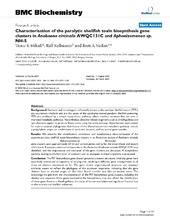| dc.description.abstract | Background: Saxitoxin and its analogues collectively known as the paralytic shellfish toxins (PSTs) are neurotoxic alkaloids and are the cause of the syndrome named paralytic shellfish poisoning. PSTs are produced by a unique biosynthetic pathway, which involves reactions that are rare in microbial metabolic pathways. Nevertheless, distantly related organisms such as dinoflagellates and cyanobacteria appear to produce these toxins using the same pathway. Hypothesised explanations for such an unusual phylogenetic distribution of this shared uncommon metabolic pathway, include a polyphyletic origin, an involvement of symbiotic bacteria, and horizontal gene transfer. Results: We describe the identification, annotation and bioinformatic characterisation of the putative paralytic shellfish toxin biosynthesis clusters in an Australian isolate of Anabaena circinalis Aphanizomenon sp Nostocales gene clusters span approximately 28 kb and contain genes coding for the biosynthesis and export of the toxin. A putative insertion/excision site in the Australian Anabaena circinalis AWQC131C was identified, and the organization and evolution of the gene clusters are discussed. A biosynthetic pathway leading to the formation of saxitoxin and its analogues in these organisms is proposed. Conclusion: The PST biosynthesis gene cluster presents a mosaic structure, whereby genes have apparently transposed in segments of varying size, resulting in different gene arrangements in all three sxt clusters sequenced so far. The gene cluster organizational structure and sequence similarity seems to reflect the phylogeny of the producer organisms, indicating that the gene clusters have an ancient origin, or that their lateral transfer was also an ancient event. The knowledge we gain from the characterisation of the PST biosynthesis gene clusters, including the identity and sequence of the genes involved in the biosynthesis, may also afford the identification of these gene clusters in dinoflagellates, the cause of human mortalities and significant financial loss to the tourism and shellfish industries. | en_US |

